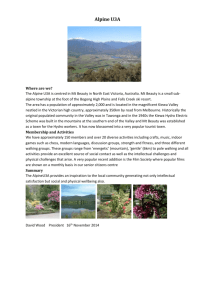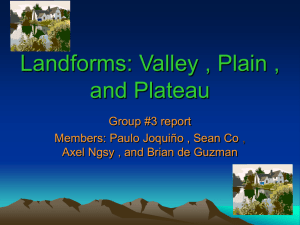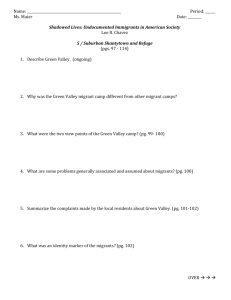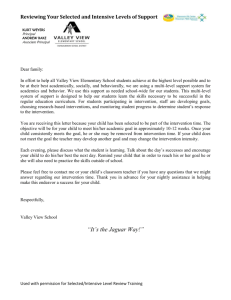Geol_quest_Resia_ok
advertisement
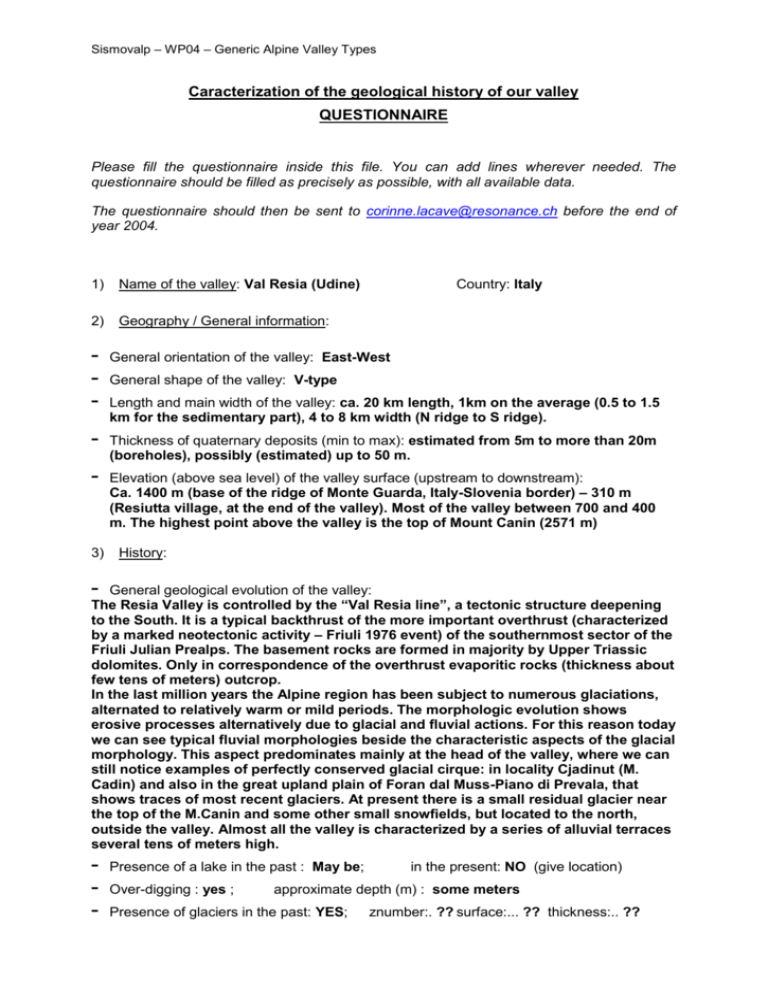
Sismovalp – WP04 – Generic Alpine Valley Types Caracterization of the geological history of our valley QUESTIONNAIRE Please fill the questionnaire inside this file. You can add lines wherever needed. The questionnaire should be filled as precisely as possible, with all available data. The questionnaire should then be sent to corinne.lacave@resonance.ch before the end of year 2004. 1) Name of the valley: Val Resia (Udine) 2) Geography / General information: Country: Italy - General orientation of the valley: East-West - Thickness of quaternary deposits (min to max): estimated from 5m to more than 20m (boreholes), possibly (estimated) up to 50 m. - Elevation (above sea level) of the valley surface (upstream to downstream): Ca. 1400 m (base of the ridge of Monte Guarda, Italy-Slovenia border) – 310 m (Resiutta village, at the end of the valley). Most of the valley between 700 and 400 m. The highest point above the valley is the top of Mount Canin (2571 m) 3) General shape of the valley: V-type Length and main width of the valley: ca. 20 km length, 1km on the average (0.5 to 1.5 km for the sedimentary part), 4 to 8 km width (N ridge to S ridge). History: - General geological evolution of the valley: The Resia Valley is controlled by the “Val Resia line”, a tectonic structure deepening to the South. It is a typical backthrust of the more important overthrust (characterized by a marked neotectonic activity – Friuli 1976 event) of the southernmost sector of the Friuli Julian Prealps. The basement rocks are formed in majority by Upper Triassic dolomites. Only in correspondence of the overthrust evaporitic rocks (thickness about few tens of meters) outcrop. In the last million years the Alpine region has been subject to numerous glaciations, alternated to relatively warm or mild periods. The morphologic evolution shows erosive processes alternatively due to glacial and fluvial actions. For this reason today we can see typical fluvial morphologies beside the characteristic aspects of the glacial morphology. This aspect predominates mainly at the head of the valley, where we can still notice examples of perfectly conserved glacial cirque: in locality Cjadinut (M. Cadin) and also in the great upland plain of Foran dal Muss-Piano di Prevala, that shows traces of most recent glaciers. At present there is a small residual glacier near the top of the M.Canin and some other small snowfields, but located to the north, outside the valley. Almost all the valley is characterized by a series of alluvial terraces several tens of meters high. - Presence of a lake in the past : May be; Over-digging : yes ; in the present: NO (give location) approximate depth (m) : some meters Presence of glaciers in the past: YES; znumber:. ?? surface:... ?? thickness:.. ?? Sismovalp – WP04 – Generic Alpine Valley Types - 4) Historical seismic activity: YES; max Intensity: ..VIII (in the valley, 1976) max magnitude:.6.4 (Friuli 1976), 5.7 (Bovec-Krn 1998), 6.9 (Idrija 1511) Location: about 10 km to the south for Friuli 1976, 20 km to the east for Bovec-Krn 1998, about 50 km to the SE for the Idrija 1511 Type of source data : - Boreholes? YES (Friz & Gatto, 1979) - Ambient vibrations? NO (planned within Sismovalp) Gravimetry? YES (measurements done within Sismovalp) Seismic? YES (type) seismic characterization of first 30 m (measurements done within Sismovalp) Others: station strong motion: STOL (Etna accelerograph/RAF network) References: http://www.dst.units.it/raf/Welcome.html Sismovalp project Friz, C. and Gatto, G., 1979. Rapporto tra ambiente geologico e rischio sismico in Val di Resia (Friuli). Memorie Museo Tridentino Scienze Naturali, Vol. XXIII, Nuova serie, fascicolo unico. Vaia, F. and Zorzin, R., 1982. Fenomeni di tettonica recente in Val Resia (Prealpi Giulie). Gortania – Atti Museo Friul. Storia Nat., Vol 3, 5-20. 5) Human activity: - Urbanised surface: less then 1400 inhabitants concentrated mainly in four small villages (population density) - Industrial activity: NO; type: - 6) Geology: 6.1) Bedrock: - Bedrock type (both sides): mainly dolomites, some limestones, few evaporites Average slope (both sides): 40° - 50° Outcrop of bedrock inside the valley: YES 6.2) Quaternary deposits (valley filling and lateral deposits): - Description of the quaternary deposits constitutive materials: - alluvial : gravels - lacustrine : silt and clay - torrential : pebbles, scree - morainic : pebbles, sands and clays - others : conglomerates Sismovalp – WP04 – Generic Alpine Valley Types - General dip direction of the deposits: gently from East to the West - Artificial fills : NO 7) - Mud flow channel: NO Fan delta: NO Lacustrine delta: NO Marsh / peat bog : NO Collapse zone : NO Landslide, creeping : NO Rockfall activity : YES mainly on the left side Scree deposits on the sides : YES Lateral water stream, torrent, secondary valley : YES ; type : about 7 small and a medium secondary torrent are present on the south (left) flank of the valley Others : Presence of some erratic rocks Attached documents : Geological map of the valley (with structural info): available on paper Cross-sections Remarks: available on paper


